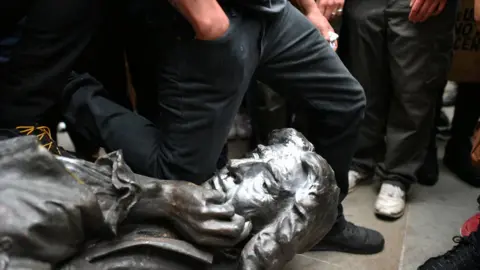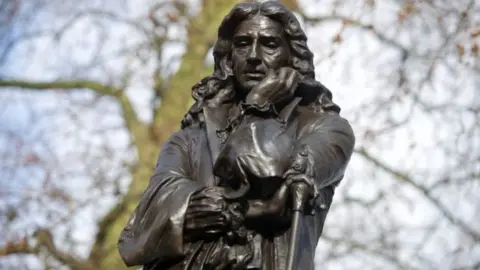Edward Colston statue toppling was 'difficult to predict'
 PA Media
PA MediaAn investigation has found that it was "difficult" for police to predict that a statue of a slave trader would be pulled down during a Bristol protest.
The statue of Edward Colston was taken from its plinth and thrown in the city's harbour last June.
A report by Her Majesty's Inspectorate of Constabulary and Fire and Rescue Services (HMICFRS) said the toppling of statues was a "very rare occurrence".
Avon and Somerset Police welcomed the "fair and measured" report.
HMICFRS investigated the force's handling of the Black Lives Matter protest in Bristol last summer as part of a wider report commissioned by the Home Secretary into how effectively the police manage demonstrations.
The protest happened in the wake of the death of American George Floyd, who died in Minneapolis during a police arrest.
 Dave Betts
Dave BettsThe bronze statue of Colston was on the intended route of the protests but although police had concerns it may be targeted, they had "no specific intelligence" that it would be pulled down, the report said.
"Without intelligence to suggest the protesters' intentions, it would have been difficult to predict that the statue would be pulled down. In the UK, this is a very rare occurrence," they said.
Inspectors said that police contacted Bristol City Council on 5 June to alert them to the possibility of damage to the statue, asking them to consider measures to protect it.
The council said that a decision had been taken at an online strategic co-ordinating group meeting, also involving the police, on the day before the protest that it was not necessary to protect the statue.
 PA Media
PA MediaThe HMICFRS inspectors said: "It is clear that, even in the absence of any intelligence to indicate that the Colston statue was going to be attacked, the multi-agency strategic group did consider the possibility of graffiti.
"Police attendees at the meeting told us that they weighed up the risks of what they thought may be minor damage to the statue against the risk of provoking major disorder by covering it up.
"The police received a lot of criticism on social media and in the press following the damage to the statue. Having examined the facts, we don't believe this criticism was fully justified."
However, the report adds that considering the history behind the statue and the nature of the protest police could have "anticipated that the statue might be damaged in something other than a minor way".
'Measured and sensible'
It also said police could have made stronger representations to the council to protect the statue by, for example, boarding it up.
The report stated that at a multi-agency debrief held after the protest, it was noted that pulling down the statue had not been a spontaneous act, as ropes had been brought to the location.
Inspectors praised Chief Constable Andy Marsh's comments to the media in the aftermath of the protest, calling them "measured and sensible".
Mr Marsh said at the time that intervening to arrest suspects was likely to have led to injuries to suspects and officers, as well as a potentially "very violent confrontation with the police that could have had serious ramifications for the city of Bristol and beyond".
He welcomed the findings of the report, adding: "I whole-heartedly believe the command team made the right decisions on the day in extremely unique circumstances."
Four people are due to stand trial over the damage at Bristol Crown Court in December.

Follow BBC West on Facebook, Twitter and Instagram. Send your story ideas to: [email protected]
